 |
 |
 |
 |
|
Dancing Star Foundation Announces a New Partnership with the Santa Fe (New Mexico) Botanical Garden
The Santa Fe Botanical Garden is committed to protecting our delicate ecosystem and biodiversity through preserving our habitat and modeling how to prepare gardens for an uncertain future. We are stewards of a public garden in the city on Museum Hill, and the Leonora Curtin Wetland Preserve located fifteen miles southwest of the City center, and we support a robust educational reach in our community. However, the organization currently has only a modest research arm. With its new partner, the Dancing Star Foundation, the Botanical Garden will be able to deepen and expand the research we conduct and share with both the scientific community and the public through educational interpretive plans for Leonora Curtin Wetland Preserve and the Piñon Juniper Woodland, a new phase at the Museum Hill site opening in 2019. The Botanical Garden currently works with a dedicated group of citizen science volunteers who monitor the biodiversity of plants, birds, nests, dragonflies, butterflies, and bumblebees at our sites.
A founding member of the Rio Grande Phenology Network, the Garden tracks seasonal change up and down the Rio Grande Valley with the National Phenology Network. After receiving a grant from the Institute of Museum and Library Services, we created a full database of our plants through IrisBG. We founded a Master Naturalist program in collaboration with Audubon NM and other partners to help share best practices and build ecological collaborations across our region. Although the Botanical Garden is proud of the thousands of data points we currently log each year, we want to have a broader reach that benefits our community, while deepening our understanding of trends during this critical period of climate change. Through the support of and partnership with the Dancing Star Foundation, the Botanical Garden is able to expand the scope and capacity of its research in the critical study of biodiversity.
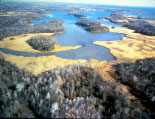 |
||
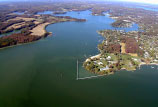 |
||
| Aerial views of SERC property on the Rhode River from the watershed, showing forests, wetland, and subestuary extending to Chesapeake Bay in the background. SERC file photo. ©SERC | ||
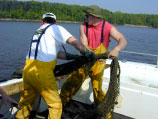 |
||
| SERC ecologists pull in a trawl net used to monitor variation in species composition and abundance of fish and crabs in the Rhode River estuarine ecosystems. Photo by SERC Biological Technician Alicia Young. ©SERC | ||
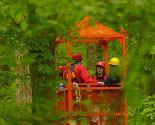 |
||
| SERC biologists in a gondola are hoisted up by a crane to sample the vertical layers of the tree canopy in forest ecosystems. Photo by SERC Education Director Mark Haddon.©SERC | ||
http://mdtf.undp.org/yasuni
Smithsonian Environmental Research Center
Project Director: A. Mark Haddon, Education Director
Project Team: Anson H. Hines, Ph.D., Marine Ecologist and Director
Thomas E. Jordan, Ph.D., Chemical Ecologist
Monaca Noble, Biologist
Smithsonian Environmental Research Center
PO Box 28, 647 Contees Wharf Road, Edgewater, MD 21037
ecosystems.serc.si.edu/
Collaborating Executive Producers:
Michael Tobias and Jane Morrison
Dancing Star Foundation
The Smithsonian Environmental Research Center (SERC) in Edgewater, MD, is developing a series of innovative video and web-based stories that will explain and teach diverse audiences about ecological change and human impacts in the coastal zone. SERC is a leading national research center for understanding the connected ecosystems at the edge of the land and sea – a complex landscape that is home to 70 percent of the global population and subject to intensive human activity. Over the past 45-years of accelerating environmental change and degradation, SERC's multi-disciplinary teams of researchers have addressed pressing environmental issues, including global change, watershed dynamics, maintenance of productive fisheries, biological invasions, pollution by nutrients and toxic chemicals, and sustaining the good and services of key ecosystems. SERC research and education programs use its unique site on the Chesapeake Bay as a model for research and teaching about the biocomplexity, environmental change, and stewardship of coastal landscapes.
Ecosystems on the Edge will develop an array of stories through a series of 15 five-to-eight minute videos about SERC's scientific research encompassing 2,650 acres of land surrounding the Rhode River, a subestuary of Chesapeake Bay located 25 miles east of Washington, D.C. The series of mini-videos will communicate via web technologies the urgent environmental science issues to millions of people world-wide. Filmed in a cinéma vérité fashion to convey that science is in fact an unscripted endeavor, Ecosystems on the Edge aims to create a more realistic view of the profession and the scientific process. The mini-videos will show ecologists, biologists and chemists exploring complex questions about global change, watershed dynamics, maintenance of productive coastal food webs, invasive species, nutrient and chemical pollution, and land use. The videos will make these investigations accessible to a wide audience that includes students as well as those interested in gaining a better understanding of the scientific process, ecosystems and the human impact on the environment.
Ecosystems on the Edge aims to increase scientific literacy and introduce viewers to coastal ecosystems as well as SERC's core research areas. While each video will be self-contained, the 15 videos are thematically linked by the ecosystems in a coastal watershed: the atmosphere, forest, farmland, wetlands, streams and the Chesapeake Bay estuary. Viewers will also learn how key environmental issues unfold in these interconnected systems.
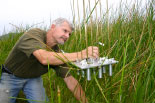 |
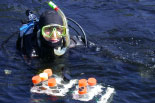 |
 |
||
| SERC technician measures effects of sea level rise in salt marsh ecosytems. Photo by SERC Science Writer Kimbra Cutlip. ©SERC |
SERC divers collect samples for mercury and other trace metals in bottom sediments in aquatic ecosystems. Photo by SERC Chemistry Technician Georgia Riedel. ©SERC |
A blue crab tagged by SERC fishery biologists to track movement and impacts of fishing. Photo by Biological Technician Alicia Young. ©SERC |
||
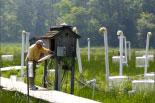 |
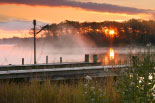 |
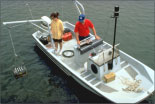 |
||
| SERC plant ecologist measuring effects of elevated levels of CO2 in global change experiments on salt marsh ecosystems. Photo by SERC Science Writer Kimbra Cutlip. ©SERC |
Mist at sunrise on edge of the Rhode River. Photo by SERC Phytoplankton Ecologist Charles Gallegos. ©SERC |
SERC plankton ecologists measure water quality in estuarine ecosystems. SERC file photo. ©SERC |
||
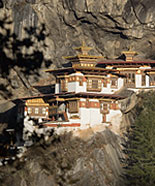 |
|
 |
|
 |
|
http://alaska.fws.gov/fisheries/fieldoffice/juneau
PDF FILE: of Michelle Kissling's Research
Kittlitz’s Murrelet Cooperative Study in Icy Bay, Alaska
U.S. National Park Service
PDF FILE: KIMU Proposal
PDF FILE: Kittlitz’s Murrelet Fact Sheet 2008
Conservation International
Conservation International's President, Dr. Russell A. Mittermeier, is the on-camera host of Dancing Star Foundation's new feature film documentary "Hotspots", based upon Dr. Mittermeier and colleagues' remarkable book, Hotspots Revisited: Earth's Biologically Richest And Most Endangered Terrestrial Ecoregions (CEMEX 2004).
Filmed in Southern California, Washington D.C., throughout Madagascar, Brazil, Peru, New Zealand and on Easter Island/Rapa Nui (Chile), "Hotspots" profiles techniques to save endangered species and habitat across the planet.
See HOTSPOTS on the DSF website for more info.
www.conservation.org/
![]() BACK TO TOP
BACK TO TOP
![]()
UNOPS – United Nations Office for Project Services
In December, 2012 Dr. Tobias made a fact finding survey in Haiti under the
auspices of UNOPS with a goal of endeavoring to better gauge the prospects
for Haiti's first national Park, Pic Macaya. See How A Single National Park Might Help Transform a Nation ... - Forbes
![]()
National Biodiversity Centre - Bhutan
Based in Serbithang, on the outskirts of the capital of Thimphu, the National Biodiversity Centre of Bhutan was created by Dr. Ugyen Tshewang, named a DSF Research Fellow in 2007. As part of its mandate, the National Biodiversity Centre not only maintains the nation's herbarium and gene bank, but is charged with creating the country's national Biodiversity Action Plans, under the Royal Government of Bhutan's signatory obligation to the United Nations Convention on Biological Diversity, which first came into being as a result of the 1992 Rio Earth Summit.
The Convention's Biodiversity Action Plans (BAPs) are conservation five-year blueprints mandated by the Convention for each of the nearly 190 countries that are signatory to it. Bhutan its third BAP, which was released at a particularly critical time for the nation. On March 24, 2008 Bhutan held its first democratic election of a Prime Minister and National Assembly since the country was founded, a century ago. The Biodiversity Action Plan III is a critical blueprint for a new democracy's conservation planning and implementation. With its existing policy of keeping at least 60% of its native forests in pristine condition, the new democracy and economy will provide great challenges and opportunities for Bhutan to maintain its outstanding global example of in situ conservation.
Dancing Star Foundation worked with the National Biodiversity Centre (NBC) as a consultant to the document. Michael Tobias served as the international Advisor for BAP III, working with a team of more than 20 Bhutanese technical experts whose respective research was coordinated at NBC under The Ministry of Agriculture's guidance.
The book which should hopefully provide invaluable conservation data for nations and NGOS throughout the world and was published in December 2009 by The Royal Government of Bhutan.
![]()
Mountain Hazelnut Venture
A small landlocked Himalayan nation, Bhutan is blessed with a stable democracy, and engaged and cohesive civil society and one of the world's greatest biodiversity hotspots. Though Bhutan has noble aspirations of developing sustainably and equitably through its Gross National Happiness (GNH) model, economic opportunities remain limited and the ability to earn income in rural areas is particularly limited due to poor market access and infrastructure, leading to rural-to-urban migration. As an elderly villager in Yurung County noted, "All our children are leaving for the cities. It is only us older people left to maintain our fields, our culture and traditions. If there were an opportunity for income in the villages, many would stay – there are no jobs for our kids in the city anyway." At the same time, many tens of thousands of acres of mid-elevation mountain slopes in Bhutan have been degraded through overgrazing and deforestation, leading to deteriorating soil and water quality, landslides, biodiversity loss and other negative micro-climatic impacts.
Mountain Hazelnut Venture or MHV plays a pioneering role in the nation's development. MHV takes a systemic approach to creating reliable income generation opportunities for Bhutan's poorest families while restoring ecosystem health and maintaining community cohesion. Over a five-year period, 10 million hazelnut trees, a crop with a long shelf life ideally suited to Bhutan's mountainous climate, are being planted exclusively on degraded or fallow land. MHV, in partnership with the Ministry of Agriculture and Forests (MoAF), provides farmer training and outreach, support in developing local cooperatives, and transport from remote villages to well-paying international markets. The long-living hazelnut trees will stabilize eroding mountain soils, alleviate deforestation pressures from fuelwood, and sequester up to 1.5 million metric tones of CO2-eq comparable to almost three times the annual CO2 emissions generated by the entire population of Bhutan, or 3.5 million barrels of oil. The project is expected to double the income of participating farmer households, which MoAF estimates will include up to 15% of Bhutan's population.
MHV was introduced to Bhutan by Dr. Michael Tobias and some of the Dancing Star Foundation's key contacts, including DSF's honored Research Fellows, Dr. Ugyen Tshewang, Founder of the national Biodiversity Centre in the country, as well as the National Herbarium and presently the Secretary for the National Environment Commission. Previously, the MHV team had developed a major reforestation and sustainable forestry business in the Himalayan foothills of Sichuan, China, engaging 650,000 farmers in tree planting. In considering new opportunities, MHV approached Dr. Tobias for insights on environmental aspects of the new venture. Dr. Tobias guided MHV's Chief Scientist, as well as it Chairman, on their collaboration with the government of Bhutan. MHV is in the process of investing US$ 30 million in Bhutan and making a significant difference in the lives of many of its citizens, while restoring environmental health to impacted areas in the Himalayas that are especially vulnerable to the mal-effects of climate change.
![]()
Royal Society for the Protection of Nature
![]()
Voice For A Viable Future
Howard Lyman, President and founder of the nonprofit organization Voice For A Viable Future, co-produced and starred as himself in the Dancing Star Foundation co-production, "Mad Cowboy". (Read more about the film on the DSF Website). See www.madcowboy.com.
![]()
Population Communication
Bob Gillespie, President and founder of the nonprofit organization Population Communication, is one of the world's leading family planning experts. Dancing Star Foundation is proud to have collaborated with him, as well as his colleague, Producer Elizabeth Hughes at Population Communication, on the production of "No Vacancy," which is hosted by Mr. Gillespie.
For more information on the film, visit No Vacancy on the DSF web site.
![]() BACK TO TOP
BACK TO TOP

